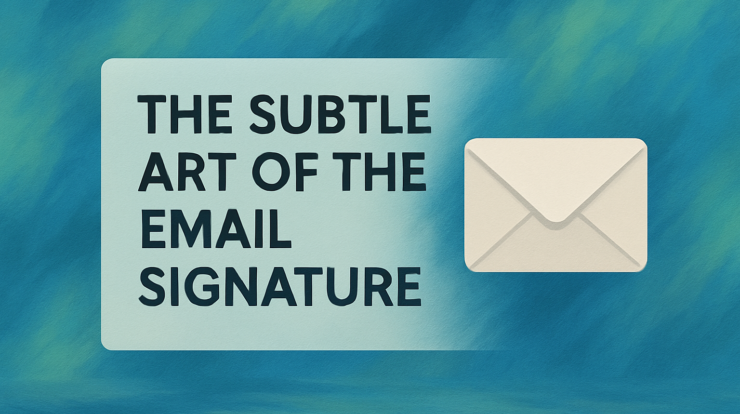
Email isn’t glamorous—but it’s essential. You use it to communicate with collectors, curators, galleries, show organizers, press contacts, workshop attendees, and more. It’s part of your professional identity, whether you’re replying to an inquiry or confirming a shipment.
And yet, most artists miss an easy, underused opportunity: the email signature.
Done well, your email signature can quietly reinforce your credibility, extend the reach of your artwork, and drive traffic to your website—without ever feeling like a sales pitch. It’s not about marketing aggressively. It’s about showing up consistently as an artist.
Here’s how to make your signature work for you.
Why Your Email Signature Matters
Think of your email signature as a digital calling card. It’s the last thing someone sees before they close the message—and often the only thing they remember if they return to it later.
A professional email signature:
-
Reinforces your identity as a working artist
-
Makes it easy for people to find your work
-
Adds a touch of visual interest (when done tastefully)
-
Signals that you’re serious about your art career
It’s subtle. It’s automatic. And once it’s set up, it works quietly on your behalf with every email you send.
What to Include (and What to Leave Out)
At a minimum, your email signature should include:
-
Your full name
-
Your role (e.g., “Visual Artist,” “Sculptor,” “Painter,” etc.)
-
A link to your website or portfolio
-
Your Instagram or one other key social media link (if active and relevant)
Optional, but highly recommended:
-
A small image of one piece of your artwork
-
A clickable thumbnail or logo (linked to your site)
-
A brief tagline or quote if it reflects your work clearly
What to leave out:
-
Multiple links to every social platform you’ve ever used
-
Long quotes or personal mantras
-
Oversized images or animated gifs
-
Contact info you don’t actively use (old phone numbers, outdated blogs, etc.)
Using an Image: Best Practices
Including an image of your work in your email signature is one of the easiest ways to make your communication visually memorable. But it needs to be handled carefully.
Keep it small and simple:
-
Ideal width: 300–400px
-
File size: under 100KB if possible
-
Format: .JPG or .PNG
Don’t clutter your design: One artwork is plenty. You’re not building a newsletter. You’re letting people see a sample of what you do—enough to create curiosity and leave a visual impression.
Update it periodically: If you’re actively creating new work, refresh the image every few months. Keep it current and relevant to your evolving style.
Link it to your website: If someone clicks the image, they should land on your homepage or portfolio, not a random file or unbranded hosting link.
Worried About Spam Filters? Here’s What You Need to Know
Yes, spam filters exist—and yes, they can be triggered by excessive images or links. But for most working artists, this is unlikely to be a major concern.
As long as your emails are:
-
Going to individuals (not mass lists)
-
Coming from a reputable email platform (like Gmail, Outlook, etc.)
-
Containing a balance of text and any image you include
…you’re not going to get flagged for including one modest image in your signature.
If you’re ever unsure, you can test your email with free spam-checking tools or consult platforms like Mailchimp, which offer reliable best practices.
Professionalism Without Pressure
The beauty of the email signature is that it’s not pushy. It doesn’t scream “BUY MY ART.” It simply reminds people: This is what I do. This is what I make. Here’s where to learn more.
It adds polish to your communication and builds brand consistency over time—especially when you’re emailing someone for the first time, applying to a show, or reaching out to a gallery.
It may seem like a small detail, but over time, those details build trust. And trust builds connections. And those connections lead to opportunities.
Final Thoughts
You don’t need to overthink it. You don’t need to turn your signature into a design project. But you do need to treat it as part of your presentation—because that’s exactly what it is.
Set it up once, review it periodically, and let it do its quiet, consistent work.
Your art is worth sharing. Even at the bottom of an email.
Jason,
This is excellent information. I can see I have my work cut out for me. When I have my “act together” I’ll give you a share. Meanwhile I’ll continue to take advantage of your wisdom.
What are your thoughts on using a QR code as the link to my web site? They are ugly but functional.
So if the goal of social media for artists is to get social media people to your website, why not just put your website? Why have them take an extra step to get there?
I do have my website after my name. I am always surprised when no. Art contacts comment that they went ahead and looked at my paintings.
Thanks for suggestions
Hi. If you have a name that is initially difficult to pronounce, would you consider adding a line in the signature of sounding it out phonetically?